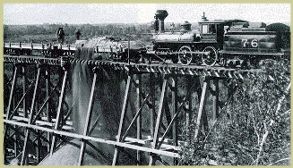 |
 |
|||||||||
 |
||||||||||
| When the area around Wawanesa was settled, small communities sprung up all over the countryside. In retrospect it seems as if each of these communities were waiting with bated breath for the legislators and railroad barons to decide where the next rail line would be laid. Milford was one such community and is a fine example of how the railway could make or break a small community. | ||||||||||
|
|
||||||||||
| Milford’s early development was very similar to that of Wawanesa, Nesbitt, and other communities that survived the coming of the railroad. In 1879, surveyors from the east were sent to the area to look for a good location for a saw mill and a grist mill. They found a valley along the Souris River that seemed ideal for their project and sent word for settlers to come from the east. Soon the community was thriving, farming expanded in the area and the mills were well used. Other businesses began to appear on the heels of the mills. A general store, a building contractor and a hotel were amongst the first. A small Methodist church and a one room school house were built in 1882. Nellie McLung, the well known political activist, was a teacher at the Northfield School. |
||||||||||
 |
||||||||||
|
|
||||||||||
| The community developed just like any other prairie settlement until the railroad came to the area in 1891. Well before the track was ever laid, the village was deserted. The knowledge that the railroad would not go through Milford caused the town's ten year history to stop abruptly. Little remains of what was once Milford; only a few families live in the valley and the village land has been rezoned and sold. What does remain, however, is the cemetery and it is quite a treasure. Milford was one of the earliest settlements and therefore there are graves that date back to the early 1880’s. Magnificent tomb stones and monuments are hidden throughout the trees and hills of the cemetery. A trip to the Milford cemetery makes for a very interesting experience. |
||||||||||
 |
||||||||||
|
|
||||||||||
|
|
||||||||||